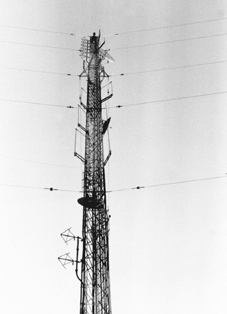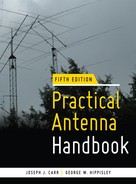CHAPTER 1
Introduction to Radio Communications
Useful communication by radio has been with us for the entire twentieth century and shows no sign of abating in the twenty-first. Originally determined to be mathematically “possible” by the Scottish inventor James Clerk Maxwell in the mid-1860s, radio waves remained science fiction until 1887, when a German, Heinrich Hertz, was first to convert Maxwell’s theoretical equations into laboratory experiments that demonstrated and confirmed their existence. Italian Guglielmo Marconi then picked up the ball and through the 1890s took the first productive steps toward making radio communication a popular and commercial success. Along the way, Nikolai Tesla from Serbia, Alexander Fessenden in Canada, Alexander Popov in Russia, and Lee DeForest in the USA were also early pioneers in advancing the state of the art. Thus, the story of radio’s inception is as international as the wireless long-distance communications it ultimately engendered.
By the turn of the century “wireless telegraphy” (as radio was called then) was sparking (pun intended) the imaginations of countless people across the world. Radio communications began in earnest, however, when Guglielmo Marconi successfully demonstrated wireless telegraphy as a commercially viable technology. The “wireless” aspect so radically changed communications that the word is still used in many countries of the world to denote all radio communications even though today in the United States the term wireless has come to be associated almost entirely with WiFi—the short-range, very short wavelength method of interconnecting computers and other digital devices. Until Marconi’s successful transatlantic reception of signals near the end of 1901, and despite his earlier success at spanning the English Channel, wireless was widely seen as a neighborhood or cross-town endeavor of limited usefulness. Of course, although ships close to shore or each other could summon aid in times of emergency, the ability to communicate over truly long distances was absent. But all that changed on that fateful December day in Newfoundland when the Morse letter “S” tickled Marconi’s ears.
Wireless telegraphy was immediately pressed into service by shipping companies because it provided an element of safety that had been missing in the pre-wireless days. In fact, some early shipping companies advertised that their ships were safer because of the new wireless installations aboard. It was not until 1909, however, that wireless telegraphy actually proved its usefulness on the high seas. Two ships collided in the foggy Atlantic Ocean and were sinking. All passengers and crew members of both ships were in imminent danger of death in the icy waters, but radio operator Jack Binns became the first man in history to send out a maritime distress call. His call for help in Morse code was received and relayed by nearby ships, allowing another vessel to come to the aid of the stricken pair of ships.
All radio communication prior to about 1916 was carried on via telegraphy (i.e., the on-off keying of a radio signal in the Morse code). But one night in 1916 there was more magic. Radio operators and monitors up and down the Atlantic seaboard—from the Midwest to the coast and out to sea for hundreds of miles—heard something that must have startled them out of their wits: crackling out of the “ether,” amid the whining of Alexanderson alternators and the zzzchht of spark-gap transmitters, came a new sound—a human voice. Engineers and scientists at the Naval Research Laboratory in Arlington, Virginia, had transmitted the first practical amplitude-modulated (AM) radio signals. Earlier attempts (prior to 1910) had been successful as scientific experiments but did not employ commercially available equipment.
Although radio activity in the early years was unregulated and chaotic, today it is quite structured and (relatively) heavily regulated. At the international level, radio is coordinated by the International Telecommunications Union (ITU) in Geneva, Switzerland, based on treaties signed at World Administrative Radio Conferences (WARCs) held every few years. Of course, each sovereign country retains control of its own internal radio regulations. In the United States, for instance, all matters pertaining to radio communications are handled by the Federal Communications Commission (FCC), headquartered in Washington, D.C.
Amateur radio has grown from a few thousand “hams” prior to World War I to more than 900,000 today, about one-third of them in the United States. Amateurs were ordered off the air during World War I, and the hobby almost did not make a comeback after the war. There were, by that time, many powerful commercial interests greedily coveting the frequencies used by amateurs, and they almost succeeded in keeping post-war amateurs off the air. But the amateurs won the dispute—at least partially.
In those days, the frequencies with wavelengths longer than 200 m (i.e., 20 to 1500 kHz) were the ones considered valuable for communications. The cynical attitude attributed to the commercial interests regarding amateurs was “Put ’em on two hundred meters and below . . . they’ll never get out of their backyards there!” But there was a surprise in store for those commercial operators, because the wavelengths shorter than 200 m are in the high-frequency region that we now call shortwaves. Today, those short-waves are well-known for their ability to support communications over transcontinental distances, but in 1919 that ability was not suspected by anyone.
One of the authors of this book once heard an anecdote from an amateur radio operator “who was there”. In the summer of 1921 this man owned a beautiful, large, wire “flattop” antenna array for frequencies close to 200 m on his family’s farm in southwestern Virginia. Using those frequencies he was accustomed to regularly communicating several hundred miles into eastern Ohio and down to the Carolinas. Returning home at Thanksgiving of 1921 during his first semester at college, he noticed that his younger brother had replaced the long flattop array with a short dipole antenna. Confronting his brother over the incredible sacrilege, he was told that they no longer used 150 to 200 m, but were using 40 m instead. Everyone “knew” that 40 m was useless for communications over more than a few blocks, so (undoubtedly fuming) the older sibling took a turn at the key. He sent out a “CQ” (general call) and was answered by a station with a call sign similar to “8XX”. Thinking that the other station was in the eighth U.S. call district (at the time covering West Virginia, Ohio, Michigan, and western New York), he asked him to relay a message to a college buddy in Cincinnati, Ohio. The other station replied in the affirmative, but suggested that “. . . you are in a better position to reach Cincinnati than I, I am French 8XX.” (Call signs in 1921 did not yet include any system of national prefixes, such as we have today.) The age of international amateur communications had arrived! And with it came a new problem: National identifiers in call signs became necessary (which is why all U.S. call signs begin with K, W, N, or portions of the A block).
During the 1930s, radio communications and broadcasting spread like wildfire as technology and techniques improved. World War II became the first war to be fought with extensive electronics. Immediately prior to the war, the British developed a new weapon called RADAR (RAdio Detection And Ranging; now spelled radar). This tool allowed them to see and be forewarned of German aircraft streaming across the English Channel, planning to strike targets in the United Kingdom. The German planes were guided by (sophisticated for their times) wireless highways in the sky, while British fighters defended the home islands by radio vectoring from ground controllers. With night fighters equipped with the first centimeter (i.e., microwave) radar, the Royal Air Force was able to strike the invaders accurately—even at night. The first kill occurred one dark, foggy, moonless night when a Beaufighter closed on a spot in the sky where the radar in the belly of the plane said an enemy plane was flying. Briefly thinking he saw a form in the fog, the pilot cut loose a burst from his quad mount of 20-mm guns slung in the former bomb bay. Nothing. Thinking that the new toy had failed, the pilot returned to base—only to be told ground observers had reported that a German Heinkle bomber fell from the overcast sky at the exact spot where the pilot had his ghostly encounter!
Radio, television, radar, and a wide variety of services are available today under the general rubric “radio communications and broadcasting”. Increasing numbers of families now obtain their radio and television broadcasts via small dishes aimed at satellites in geosynchronous orbit 23,000 mi out in space. Inside, these same families network their home computers, audio/video equipment, and printers with wireless nodes. Amateur operators are able to communicate worldwide on low power and have even launched their own “OSCAR” satellites. And, of course, no summary of present-day radio communications would be complete without mentioning the ubiquitous cell phone.
Whether visible or hidden inside the consumer’s device, antennas are required at both ends of the circuit for each of these communications systems. Thus, the antenna is arguably one of the most important parts of the receiving and/or transmitting station (Fig. 1.1). That is what this book is all about.

FIGURE 1.1 This AM/FM broadcast tower bristles with two-way antennas.
